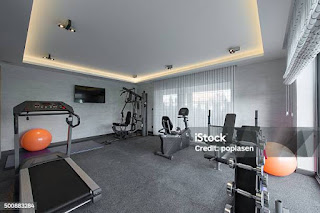Home Gym Essentials: Building a Comprehensive Workout Space
Building a home gym isn’t just about replicating a commercial gym; it’s about creating a personalized fitness haven that meets your needs and motivates you to keep pushing toward your health goals.
Introduction to Home Gyms
In recent years, the concept of home gyms has gained significant traction among fitness enthusiasts. The allure of a personal workout space is undeniable. It offers the freedom to exercise on your schedule, eliminates commuting time, and provides privacy, which can be particularly beneficial for beginners or those uncomfortable in crowded gym settings.
Choosing the Right Space
The first step in creating a home gym is choosing the right space. Whether it’s a spare room, a corner of the living room, or a converted garage, assess the available space and consider how it can accommodate your workout needs. For smaller areas, clever organization and space-saving equipment become crucial.
Essential Equipment for Every Home Gym
A. Space and floor
1. Dedicated area: Your gym should have enough space for movement and equipment. Consider a spare room, garage, or a corner of a living space. To make sure there is adequate room for poses like lunges, squats, and yoga, measure the space.
2. Flooring: Gym-specific flooring protects your home floor and provides cushioning for high-impact exercises. Rubber mats or interlocking foam tiles are great options. They produce a comfortable training surface, lessen noise, and absorb shock.
B. Basic equipment
1. Free weights: Dumbbells are versatile and come in different weights, allowing for a range of exercises. Kettlebells improve coordination, strength, and endurance. Progressive resistance is provided by barbell sets with weight plates, which is crucial for developing strength.
2. Resistance Bands: These elastic bands come in different resistance levels, which exercise the whole body and help with stretching and mobility exercises.
3. Exercise Ball: Known to improve core strength and stability, it's great for balance training, core strengthening, and stretching exercises.
4. Jump Rope: Simple yet effective for cardiovascular workouts, improving agility and coordination.
C. Cardio equipment
1. Static bikes or treadmills: Static bikes imitate running, jogging, or walking indoors. Stationary bikes offer a low-impact cardio option. Choose based on your preferred cardio workout.
2. Elliptical Trainer: A low-impact, full-body workout that simultaneously works the arms, legs, and core.
D. Strength training
1. Power Rack or Squat Stand: This sturdy structure is essential for heavy lifting, providing safety and stability for exercises like squats, bench presses, and pull-ups.
2. Bench: By allowing for various workout angles, an adjustable bench increases the number of exercises possible, including step-ups, rows, and chest presses.
3. Pull-up bar: This unit, which can be mounted on a wall or used independently, is excellent for strengthening the arms, back, shoulders, and upper body.
E. Additional accessories
1. Foam roller: Promotes self-myofascial release, decreases soreness in the muscles, increases flexibility, and helps muscles heal.
2. Mirror: Having a mirror in your gym space helps you maintain proper form during exercise, allowing for better feedback on your technique.
3. Speakers or music system: Music can be a powerful motivator during a workout, so consider adding speakers or a music system to keep you pumped up.
F. Consideration
1. Budget: Allocate your budget wisely based on your fitness goals and prioritize equipment accordingly.
2. Versatility: Choose tools that serve multiple purposes to get the most out of your space and investment.
3. Storage: Invest in storage solutions like racks or shelves to keep your gym space organized and safe when not in use.
G. personal touch
1. Inspirational space: Create an inspiring environment with posters, quotes, or visuals that motivate you and drive you toward your fitness goals.
2. Comfortable seating: Have a designated area for resting between sets or stretching post-workout to make your space comfortable and inviting.
Remember, your home gym is a personal space, so tailor it to your preferences and fitness routine so you enjoy it and stay motivated to work out regularly.
Creating a Functional Setup
An often overlooked yet crucial aspect of a home gym is proper flooring. Ensure the surface can withstand the equipment and provide adequate cushioning for impact. Additionally, organize the equipment strategically for accessibility and safety.
Incorporating Variety in Workouts
Variety is key to maintaining enthusiasm and effectively challenging your body. Incorporating elements of flexibility, like a yoga mat or foam roller, adds diversity to your routine and aids in recovery.
The Importance of Safety Measures
Safety should be a priority in any fitness environment. Establish safety protocols and regularly inspect equipment for wear and tear to prevent accidents or injuries.
Budgeting and Cost Considerations
Balancing quality and cost is essential. While it's tempting to opt for the cheapest equipment, investing in durable, high-quality items ensures longevity and safety. DIY options can also be cost-effective if done correctly.
Customizing Your Home Gym
Personalize your space with motivational elements like posters, quotes, or a dedicated workout playlist. Incorporating technology, such as fitness apps or streaming services, can make workouts more enjoyable.
Maintaining Consistency and Motivation
Staying disciplined in a home setting requires commitment. Establish a routine, set achievable goals, and consider accountability strategies like workout buddies or tracking apps to stay motivated.
Building a comprehensive home gym isn’t just about the equipment; it’s about creating a space that inspires and supports your fitness journey. By carefully selecting equipment, optimizing the space, and staying committed, you can create a workout sanctuary that motivates you to achieve your fitness goals.
FAQs
1. Can I build a home gym on a tight budget? Building a budget-friendly home gym is possible by prioritizing essential equipment and considering DIY options for certain items.
2. How much space do I need for a home gym? The space needed depends on the type of workouts and equipment. Even a small area can be optimized for effective workouts.
3. Are bodyweight exercises enough for a home workout? Bodyweight exercises can be highly effective. However, incorporating some equipment can add variety and challenge to your routine.
4. How do I maintain and clean home gym equipment? Regular maintenance involves wiping down equipment after use and periodically checking for wear or damage.
5. Is it necessary to have mirrors in a home gym? Mirrors can be helpful for maintaining proper form during workouts but aren't essential for everyone.






